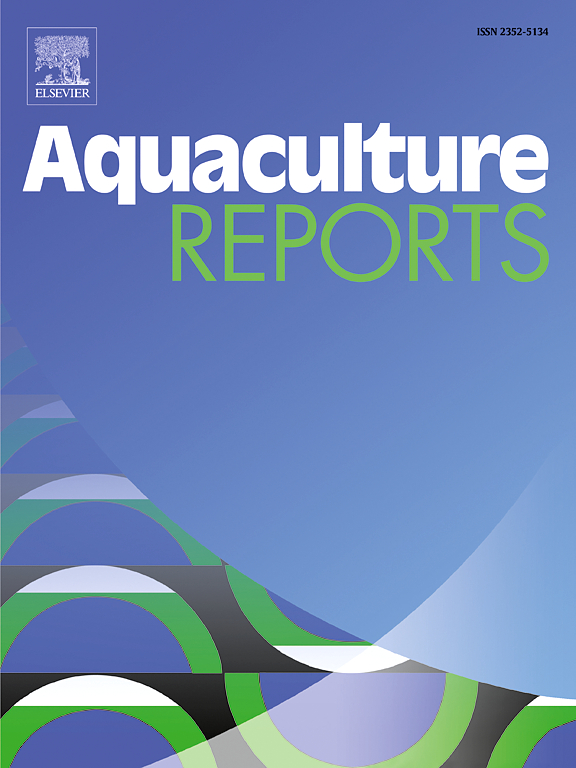Comparative transcriptome analysis reveals pathogenesis of Procambarus clarkii during Black May Disease
IF 3.7
2区 农林科学
Q1 FISHERIES
引用次数: 0
Abstract
Black May Disease (BMD) is a common illness that affects Procambarus clarkii during the spring-to-summer transition. With a complex pathogenesis, it poses a serious threat to aquaculture safety and industry stability. To better understand the progression of BMD, this study integrates key hepatopancreatic enzyme activity data with intestinal transcriptome profiles. We systematically investigated the immune, antioxidant, and metabolic adaptations of P. clarkii across different stages of the disease from both functional and molecular perspectives. The results showed a continuous increase in the relative abundance of Aeromonas, a typical opportunistic pathogen, throughout disease progression. This was accompanied by a gradual decline in the activities of key enzymes such as AKP, ACP, LPS, and SOD, indicating impaired nonspecific immune responses and basal metabolic functions. Several critical pathways—including PI3K-Akt, NOD-like receptor, Toll and Imd, AMPK, and glutathione metabolism—were significantly activated in the early disease stage (S2), sustained in the mid-stage (S3), and declined during the terminal stage (S4), reflecting a typical “early activation–mid-stage maintenance–late-stage decline” pattern. Pathways related to endocytosis, autophagy, and cell adhesion were consistently downregulated in the later stage, suggesting a systemic weakening of the intestinal barrier function. This study reveals a regulatory framework in which the accumulation of pathogens and external stress jointly disrupt the immune, metabolic, and structural defense systems. These findings offer theoretical insights and foundational data for understanding the pathogenesis of BMD and developing health management strategies for P. clarkii.
比较转录组分析揭示了克氏原螯虾在黑五月病中的发病机制
黑五月病(BMD)是一种常见病,影响克氏原螯虾在春季到夏季的过渡。其发病机制复杂,对水产养殖安全和产业稳定构成严重威胁。为了更好地了解BMD的进展,本研究将关键的肝胰脏酶活性数据与肠道转录组谱结合起来。我们从功能和分子角度系统地研究了克氏杆菌在疾病不同阶段的免疫、抗氧化和代谢适应。结果显示,在整个疾病进展过程中,气单胞菌(一种典型的机会致病菌)的相对丰度持续增加。这伴随着关键酶如AKP、ACP、LPS和SOD活性的逐渐下降,表明非特异性免疫反应和基础代谢功能受损。包括PI3K-Akt、nod样受体、Toll和Imd、AMPK和谷胱甘肽代谢在内的几个关键通路在疾病早期(S2)显著激活,在中期(S3)持续,在终末期(S4)下降,反映了典型的“早期激活-中期维持-晚期下降”模式。与内吞作用、自噬和细胞粘附相关的通路在后期持续下调,表明肠道屏障功能全身性减弱。这项研究揭示了一个调控框架,在这个框架中,病原体的积累和外部压力共同破坏了免疫、代谢和结构防御系统。这些发现为了解克拉氏杆菌骨密度失调的发病机制和制定健康管理策略提供了理论见解和基础数据。
本文章由计算机程序翻译,如有差异,请以英文原文为准。
求助全文
约1分钟内获得全文
求助全文
来源期刊

Aquaculture Reports
Agricultural and Biological Sciences-Animal Science and Zoology
CiteScore
5.90
自引率
8.10%
发文量
469
审稿时长
77 days
期刊介绍:
Aquaculture Reports will publish original research papers and reviews documenting outstanding science with a regional context and focus, answering the need for high quality information on novel species, systems and regions in emerging areas of aquaculture research and development, such as integrated multi-trophic aquaculture, urban aquaculture, ornamental, unfed aquaculture, offshore aquaculture and others. Papers having industry research as priority and encompassing product development research or current industry practice are encouraged.
 求助内容:
求助内容: 应助结果提醒方式:
应助结果提醒方式:


